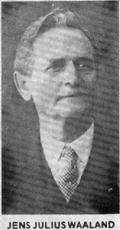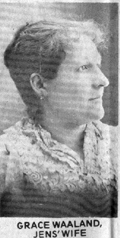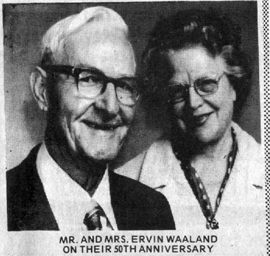December 18, 1980



Picture #1 – Jens Julius Waaland
PIX #2 – Grace Waaland, Jens’ Wife
PIX #3 – Mr. and Mrs. Ervin Waaland on their 50th Anniversary
The Potluck article which dealt with greenhouses in Fostoria developed a sequel which is presented today. After that article appeared I had a telephone call from Ervin Waaland, 100 Hughes St., Fostoria. He wondered if I had learned anything about the part his family had played in the greenhouse industry in this area. I had to admit I had not.
Waaland informed me that his father Jens Julius Waaland started working for Emerson Sackett as head grower in 1895 when Sackett’s first greenhouse was located on Maple Street. Prior to working for Sackett, Jens worked at the Heinl Greenhouse in Toledo for about 10 years.
Let’s back up a bit to provide some background information on the family… how they got the name Waaland…and their connection with the greenhouse business in this area.
It all started in Stavanger, Norway, when Ervin’s grandfather Lars was born. Then on April 27, 1866, Ervin’s father, Jens was born there too. Their real family name was Oxnevad, but back in that period in Norway, the farm on which the family lived was known as Waaland, and it was customary that the family adopt the name of the farm. So, henceforth the family name was Waaland.
According to Ervin, he and his brothers have always been glad that the family name became Waaland, instead of Oxnevad, because, “we all thought that name was a bit odd.”
APPRENTICE AT 15
At 15 years of age, according to a family historical account written by Ervin, his father Jens decided to learn the floral trade. “In those days, one had to work as an apprentice for a certain length of time. My father had to work for the first year without pay; the second year for approximately a dollar a week, and then was able to take a job in any greenhouse at regular wages.”
Later, Jens went to Germany where he worked for different florists and learned to speak German fluently. His next major move was to America, where he worked on the private estate of a brother of John Pierpont Morgan, in Boston, Mass., where he remained until 1885, when he moved to Toledo; then to Fostoria in 1895, living at 630 Maple St., close to the Sackett Greenhouse, where he started to work.
Ervin recalls that when he and his five brothers were growing up in Fostoria, he with Norman and Harold eventually discovered the stone quarry on North Main Street, opposite the present location of Fostoria Industries…back then the quarry was owned and operated by the Ohio & Western Lime Co., and they had the building which eventually became The Fostoria Pressed Steel Co. used when they started in business.
BLASTING SCARE
“On one occasion,” Ervin recalls, “when visiting the quarry, and descending to the bottom, we were greeted by a workman who shouted, ‘get out…we’re blasting.’ We ran until we found an obsolete boiler which we crawled into. When the dynamite explored, some of the stones cam belting down on the boiler. That ended our trips to the quarry.”
By 1903, with a family of five boys to raise, Waaland decided to go into business and later also bought another owned by Elijah Barnd on East Front Street in Findlay. So with that acquisition the Waaland family was transported from Fostoria to Findlay.
According to Ervin’s family narrative, the five boys continued their schooling in the Findlay schools and the family enjoyed living in Findlay. They took pleasure boat rides on the Blanchard River and swam and picnicked at Riverside Park. Ervin fell through the ice on the Blanchard River and was rescued by his brother. He also nearly drowned in the quarry at the end of Second Street, but was rescued by his father.
Ervin recalls the time he climbed the steel superstructure on the Main Street bridge and was nearly electrocuted when he touched the trolley wires.
In 1913, when Ohio experienced some of its worst floods, they also occurred in this area, and Findlay was no exception. Ervin remembers the excitement they provided and the disaster that resulted from the flooding in Findlay. The area east of Main Street was much lower and because of the Fenberg’s house and their junkyard, as well as other houses in that area were flooded to the second floor.
People had to be rescued by boat, and one policeman who couldn’t swim was drowned when his boat overturned. At the Waaland house, the water rose to 14 inches in the downstairs.
Ervin recalls that their greenhouse was flooded with water that had been enriched from manure and other debris, which enriched the dirt in the growing beds and caused excellent growing conditions.
Emerson Sackett disposed of his share of the greenhouse in Findlay in about 1911, and the Waalands later sold out too and moved to Illinois. But after making several moves they finally came back to Findlay in 1915 and bought a greenhouse on Larkins Street.
FAMILY TRADITION
Ervin’s brother, Walter, owned a greenhouse in Kenton until 1976, when the high operating costs forced its disposal. Loren, son of Ervin’s five children has a greenhouse in North Baltimore. Another son, Vernon, has the greenhouse on Larkins Street in Findlay; and Janice, the daughter, with her husband Paul, has Jan and Paul’s in Fostoria.
That’s the condensed story of how the growing of flowers got into the Waaland blook back in 1881 in Norway and still urges the descendants on today. Jens Julius Waaland, the propagator of the family trade, died in 1949.
Today, at 81, Ervin Waaland looks back on many wonderful memories of his connection with the greenhouse business. He is a very pleasant and kind man to talk to. He is proud of his heritage and his family.
ERVIN’S LATER YEARS
Ervin and his wife Ellen, to whom he was married in 1925, and to whom five children were born, decided in 1967 it was time to quit working and see some of the U.S. So, they purchased a 19-foot travel trailer and headed west. They continued their travels for several years, which included a trip to Hawaii. Ervin’s family narrative contains a complete description of their travel years.
Ellen, his wife, died in 1977, so Ervin now lives with his granddaughter, Mrs. Ron (Sheryl) Callahan.
I must tell one more incident before closing this story. Many years after Ervin had climbed the steel superstructure of the bridge, and was nearly electrocuted, he asked several electricians and finally the engineers at the electric generating plant why the electricity was momentarily shut off, and he was not electrocuted. They showed him the dynamo that furnished the 660- watts, and said that it was never turned off…it was always on. They could give no explanation for Ervin’s survival.
Ervin says, “The good Lord must have shut if off…I will ask him about it when I get to Heaven.”
RUMOR!
A rumor has been circulated that an old TF&F street car is presently stored in a barn in the Fostoria area. Anyone having full knowledge of such information, please contact Paul H. Krupp at 419-435-2707.